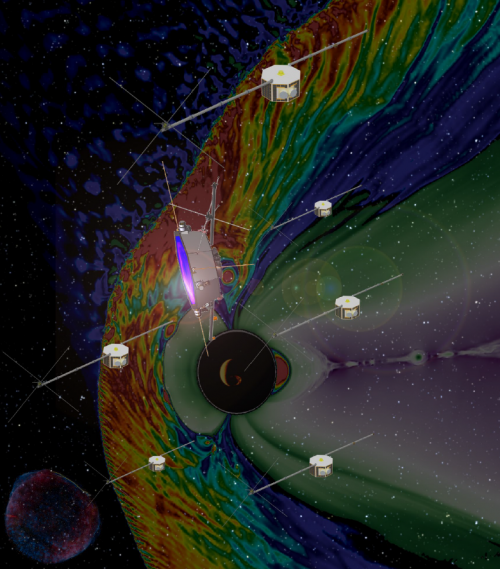BIRA-IASB scores 2 out of 3
ESA, the European Space Agency, has downselected the shortlist for its next ‘medium’ science mission to three finalists: M-Matisse, Plasma Observatory and Theseus.
In December 2021, ESA called for proposals for the next medium science mission, pencilled in for launch in the mid-2030s.
From 27 responses from scientific teams, an independent rigorous scientific and technical assessment narrowed down the number of proposals to five by end 2022. During 2023, each of those five mission concepts underwent a month-long “Phase 0 study” to further scrutinize their technical and programmatic feasibility.
Today, ESA’s Science Programme Committee endorsed a shortlist of three candidates:
- M-Matisse is a 2-satellite mission that aims to study Mars in order to shed light on its habitability and evolution;
- Plasma Observatory is a 7-satellite mission for exploring the plasma environment around Earth;
- Theseus will study high-energy, short-lived events across the cosmos.
These three mission candidates will now enter a “Phase A study” funded by ESA and its member states to come up with a complete and detailed design. For each mission candidate, ESA will ask two competing industrial consortia to make plans for building the spacecraft to identify the most cost-effective approach.
After that, one candidate mission will be selected for implementation by mid-2026.
Johan De Keyser of the Royal Belgian Institute for Space Aeronomy (BIRA-IASB) breathes a sigh of relief now that this decision is made. “We were involved in 5 proposals out of the original 27, and now we end up with 2 out of 3 selected candidates: M-Matisse and Plasma Observatory – a good score!”
The positive feelings come after repeated unsuccessful applications for other ESA Science mission opportunities in the preceding years – sometimes even going through a Phase A study, but without selection for launch.
M-Matisse: how the solar wind influences Mars’ atmosphere, ionosphere and magnetosphere.
M-Matisse would study Mars using two spacecraft, each carrying an identical set of instruments to observe Mars simultaneously from two different locations in space. In particular, M-Matisse would shed light on how the solar wind influences Mars’s atmosphere, ionosphere and magnetosphere.
The mission aims to investigate the impact of these interactions on Mars' lower atmosphere and surface, which is a key aspect to understand the Red Planet’s habitability, as well as the evolution of its atmosphere and climate.
BIRA-IASB would contribute the electric probe assemblies (a set of 2 for each of both spacecraft) as part of the COMPASS instrument suite, in a collaboration with teams from Sweden, France, Germany, and the Czech Republic. “We were asked to participate based on our expertise with a similar instrument that we are now building for ESA’s Comet Interceptor mission”, says Sylvain Ranvier, instrument engineer.
“Together with our mechanical engineering team at BIRA-IASB and inspired by our international colleagues, we have come up with an innovative design that combines a magnetic field sensor with our electric field probe – cheaper, lighter, and actually even better than having separate sensors.”
If the mission gets implemented, this would be the 3rd Mars instrument for BIRA-IASB, after SPICAM on Mars-Express and NOMAD on the ExoMars Trace Gas Orbiter.
Plasma Observatory: environment of electrically charged particles (called a plasma) around Earth
Plasma Observatory is a seven-spacecraft mission (1 “mother” spacecraft with 6 “daughters”) to study the environment of electrically charged particles (called a plasma) around Earth.
It would focus on two questions:
- How are particles energised in space plasmas?
- What processes dominate energy transport and drive interactions between the different regions of Earth’s magnetospheric system?
Plasma Observatory would complement ESA’s current and planned missions looking at the Sun-Earth interaction to support our understanding of how the solar wind affects our planet, ultimately helping us keep life and technology safe from its effects.
BIRA-IASB’s participation consists here of building the onboard processing unit for the Ion Mass Spectrometer on the mother spacecraft as part of a team involving Italy, France, Hungary, and the US.
“We have quite some heritage in doing this kind of work”, says Sophie Berkenbosch, electronics engineer at BIRA-IASB. “In particular, in recent years, we worked with the same team on a solar wind spectrometer for the THOR mission candidate, which ultimately was not selected for flight. And we did processing units, including on-board software, for several interplanetary missions to Venus (SOIR Venus-Express) and Mars (NOMAD on ExoMars Trace Gas Orbiter)”.
Learning and improving technology as we interact with the industries
“We now have a lot of work ahead: we must prepare for two missions at the same time. Although we know for sure that one of both will never fly, this work is not a waste of time: during the design of an instrument, we keep on learning and improving technology as we interact also with the industries that help us build instrument prototypes.
But of course we hope that in 2026 one of them will be selected for flight!” Johan De Keyser concludes. “We owe a special thanks to the Space Office of BELSPO overseeing the Federal Science Policy, which represents Belgium in the ESA decision bodies”.
Further reading:
Final three for ESA’s next medium science mission (ESA Science & Exploration website)
Contact
Johan De Keyser
Head of BIRA-IASB's Space Physics Division
Email: johan (dot) DeKeyser (at) aeronomie (dot) be



